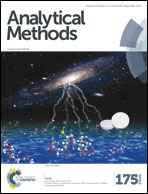Development of magnetic ytterbium oxide core–shell particles for selectively trapping phosphopeptides†
Abstract
Protein phosphorylation is one of the most important post-translational modifications and plays a key role in a large number of cellular processes. The progress in studying protein phosphorylation is largely based on the development of novel, selective and sensitive sample preparation tools for mass spectrometry. Here we report for the first time magnetic core–shell particles based on ytterbium for the selective enrichment of phosphopeptides from complex samples including human saliva. The newly fabricated Fe3O4@SiO2@Yb2O3 particles exhibit two unique features, which are specificity and response to a magnetic field. Thus, phosphopeptides are easily enriched on magnetic core–shell particles. In a further step, particles are simply removed from the sample matrix by applying a magnetic field. Electrostatic interactions, stable bidentate ligand chemistry and the high coordination number of ytterbium provide high selectivity, which was demonstrated for a spiked protein standard with a 10 000 fold background. The limit of detection was found to be in the femtomolar range for the applied mass spectrometer. Furthermore, magnetic Fe3O4@SiO2@Yb2O3 particles were compared to classical phosphopeptide enrichment by titanium oxide and revealed higher recoveries for the core–shell particles. The synthesized core–shell particles also allow the enrichment of multiply phosphorylated peptides.


 Please wait while we load your content...
Please wait while we load your content...